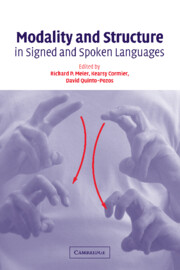Book contents
- Frontmatter
- Contents
- List of figures
- List of tables
- List of contributors
- Acknowledgements
- 1 Why different, why the same? Explaining effects and non-effects of modality upon linguistic structure in sign and speech
- Part I Phonological structure in signed languages
- 2 Modality differences in sign language phonology and morphophonemics
- 3 Beads on a string? Representations of repetition in spoken and signed languages
- 4 Psycholinguistic investigations of phonological structure in ASL
- 5 Modality-dependent aspects of sign language production: Evidence from slips of the hands and their repairs in German Sign Language
- 6 The role of Manually Coded English in language development of deaf children
- Part II Gesture and iconicity in sign and speech
- Part III Syntax in sign: Few or no effects of modality
- Part IV Using space and describing space: Pronouns, classifiers, and verb agreement
- Index
- References
6 - The role of Manually Coded English in language development of deaf children
Published online by Cambridge University Press: 22 September 2009
- Frontmatter
- Contents
- List of figures
- List of tables
- List of contributors
- Acknowledgements
- 1 Why different, why the same? Explaining effects and non-effects of modality upon linguistic structure in sign and speech
- Part I Phonological structure in signed languages
- 2 Modality differences in sign language phonology and morphophonemics
- 3 Beads on a string? Representations of repetition in spoken and signed languages
- 4 Psycholinguistic investigations of phonological structure in ASL
- 5 Modality-dependent aspects of sign language production: Evidence from slips of the hands and their repairs in German Sign Language
- 6 The role of Manually Coded English in language development of deaf children
- Part II Gesture and iconicity in sign and speech
- Part III Syntax in sign: Few or no effects of modality
- Part IV Using space and describing space: Pronouns, classifiers, and verb agreement
- Index
- References
Summary
Introduction
A pressing question related to the well-being of deaf children is how they develop a strong language base (e.g. Liben 1978). First or native language proficiency plays a vital role in many aspects of their development, ranging from social development to educational attainment to their learning of a second language. The target linguistic system should be easy to learn and use. A natural signed language is clearly a good choice for deaf children. While spoken English is a natural language, it is less obvious that a signed form of English is also a natural language. At issue is the development of Manually Coded English (MCE), which can be described as a form of language planning aimed at making English visible for deaf children (Ramsey 1989). MCE demonstrates a living experiment in which deaf children are expected to learn signed English as well as hearing children do spoken English. If MCE is a natural language, learning it should be effortless, with learning patterns consistent with what we know about natural language acquisition in general.
American Sign Language (ASL) is a good example of how a sign system is defined as a natural language with the capacity of becoming a native language for deaf children, especially those of deaf parents who use ASL at home (Newport and Meier 1985; Meier 1991). However appropriate ASL is for deaf children of deaf parents, it is not the case that all deaf children are exposed to ASL.
Information
- Type
- Chapter
- Information
- Modality and Structure in Signed and Spoken Languages , pp. 143 - 166Publisher: Cambridge University PressPrint publication year: 2002
References
Accessibility standard: Unknown
Why this information is here
This section outlines the accessibility features of this content - including support for screen readers, full keyboard navigation and high-contrast display options. This may not be relevant for you.Accessibility Information
- 9
- Cited by
